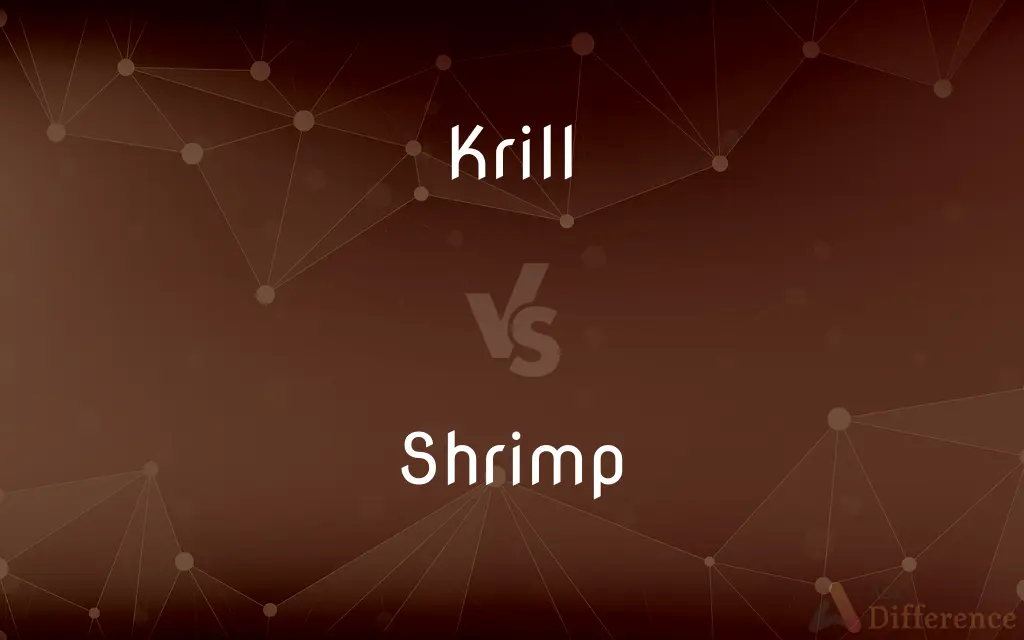Krill vs. Shrimp — What's the Difference?
Edited by Tayyaba Rehman — By Fiza Rafique — Updated on March 20, 2024
Krill are small, non-commercial crustaceans found in oceanic waters, vital in marine food webs, while shrimp are larger, widely fished crustaceans with significant culinary and economic value.

Difference Between Krill and Shrimp
Table of Contents
ADVERTISEMENT
Key Differences
Krill are tiny, predominantly Antarctic crustaceans, forming massive swarms in cold ocean waters, serving as essential nutrients for larger marine species like whales, seals, and birds. They feed on phytoplankton, contributing to the ocean's carbon cycling. Conversely, shrimp are found in a variety of aquatic environments worldwide, including both fresh and saltwater. They play a key role in the aquatic food chain and are a major commodity in the seafood industry due to their size and taste.
While krill are not typically targeted for human consumption due to their small size and specific dietary uses, such as in aquaculture feed or dietary supplements (omega-3 fatty acids), shrimp are extensively harvested and farmed for their meat. Shrimp farming is a significant part of aquaculture, providing a staple protein source in many diets globally.
Krill's exoskeleton contains astaxanthin, a potent antioxidant, which gives them and the animals that eat them a distinctive pink or red hue. Shrimp also can appear pink or red when cooked, but their coloration in the wild varies widely depending on the species. This color difference is one of many visual distinctions between the two.
The ecological roles of krill and shrimp also differ markedly. Krill are a foundational species in Antarctic ecosystems, directly affecting the survival of many marine animals. Shrimp, although important in their habitats for nutrient recycling and as prey for larger species, do not generally dominate the food web in the same way krill do in polar regions.
In terms of reproduction, krill and shrimp both lay eggs, but the quantity and reproductive strategies vary. Krill can release thousands of eggs into the water column, which develop into free-swimming larvae. Shrimp reproduction involves laying eggs that the female often carries until they hatch, releasing fully formed miniature shrimp.
ADVERTISEMENT
Comparison Chart
Habitat
Cold oceanic waters, especially Antarctic.
Various aquatic environments worldwide.
Size
Small, a few centimeters in length.
Larger, varying sizes but generally bigger than krill.
Consumption
Not commonly consumed by humans; used in supplements.
Widely consumed globally, significant in the seafood industry.
Economic Value
Lower direct economic value; used in aquaculture feed.
High economic value due to demand in the food sector.
Ecological Role
Crucial in marine food webs, especially in polar regions.
Important for nutrient recycling and as food for larger species.
Reproduction
Release thousands of eggs into the water.
Lay eggs, often carried by the female until they hatch.
Color
Often pink/red due to astaxanthin in their exoskeleton.
Varies widely; turns pink/red when cooked.
Commercial Use
Limited to dietary supplements and feed.
Extensively harvested and farmed for culinary use.
Compare with Definitions
Krill
Feed on phytoplankton, contributing to carbon cycling.
Krill play a significant role in sequestering carbon in the ocean.
Shrimp
Varied coloration, turns pink/red when cooked.
The vibrant color of cooked shrimp is due to heat breaking down proteins.
Krill
Form massive swarms, visible from space.
Satellite images can capture the vast swarms of krill in Antarctic waters.
Shrimp
Popular seafood, widely farmed and fished globally.
Shrimp cocktails are a staple appetizer in many cuisines.
Krill
Small crustaceans crucial to the Antarctic food web.
Krill swarms are a key food source for blue whales.
Shrimp
Found in diverse aquatic environments.
Freshwater shrimp contribute to the biodiversity of rivers and lakes.
Krill
Characterized by their pink/red hue from astaxanthin.
Krill's coloration is due to their diet rich in carotenoids.
Shrimp
Serve as an important protein source.
Shrimp farming is a crucial aspect of aquaculture in many countries.
Krill
Non-commercially fished, used in supplements.
Omega-3 supplements often derive from krill oil.
Shrimp
Key species in aquatic food chains.
Many fish and bird species rely on shrimp as a primary food source.
Krill
Krill are small crustaceans of the order Euphausiacea, and are found in all the world's oceans. The name "krill" comes from the Norwegian word krill, meaning "small fry of fish", which is also often attributed to species of fish.
Shrimp
Shrimp are decapod crustaceans with elongated bodies and a primarily swimming mode of locomotion – most commonly Caridea and Dendrobranchiata. More narrow definitions may be restricted to Caridea, to smaller species of either group or to only the marine species.
Krill
The collection of small marine crustaceans of the order Euphausiacea that are the principal food of baleen whales.
Shrimp
Any of various small, chiefly marine, often edible decapod crustaceans that have a laterally compressed, elongated body with long antennae and long legs used for swimming. The shrimps include species belonging to the superfamily Penaeoidea of the suborder Dendrobranchiata and to the infraorder Caridea of the suborder Pleocyemata.
Krill
Any of several small marine crustacean species of plankton in the order Euphausiacea in the class Malacostraca.
Shrimp
The flesh of one of these crustaceans, used as food.
Krill
Shrimp-like planktonic crustaceans; major source of food for e.g. baleen whales
Shrimp
Any of various similar crustaceans, such as a fairy shrimp.
Shrimp
Derogatory Slang A person who is small in stature.
Shrimp
To fish for shrimp.
Shrimp
Any of many swimming, often edible, crustaceans, chiefly of the infraorder Caridea or the suborder Dendrobranchiata, with slender legs, long whiskers and a long abdomen.
Shrimp
(uncountable) The flesh of such crustaceans.
Shrimp
(slang) A small, puny or unimportant person.
Shrimp
Synonym of butterface: a person with an attractive body but unattractive face.
Shrimp
(intransitive) To fish for shrimp.
Shrimp
To contract; to shrink.
Shrimp
To contract; to shrink.
Shrimp
Any one of numerous species of macruran Crustacea belonging to Crangon and various allied genera, having a slender body and long legs. Many of them are used as food. The larger kinds are called also prawns. See Illust. of Decapoda.
Shrimp
Figuratively, a little wrinkled man; a dwarf; - in contempt.
This weak and writhled shrimp.
Shrimp
Disparaging terms for small people
Shrimp
Any of various edible decapod crustaceans
Shrimp
Small slender-bodied chiefly marine decapod crustaceans with a long tail and single pair of pincers; many species are edible
Shrimp
Fish for shrimp
Common Curiosities
How do krill differ from shrimp?
Krill differ from shrimp in size, habitat, and their role in the food web, with krill being crucial in polar regions and not commonly consumed by humans, while shrimp are a significant part of global seafood consumption.
What are krill?
Krill are small, marine crustaceans found primarily in cold ocean waters, playing a critical role in polar ecosystems as a food source for larger marine animals.
Why are krill important to the ecosystem?
Krill are vital to marine ecosystems, especially in Antarctic waters, serving as a key food source for whales, seals, and penguins, and contributing to carbon cycling.
How are krill and shrimp harvested?
Krill are harvested primarily for use in dietary supplements and aquafeed, using specialized fishing techniques, while shrimp are caught wild and farmed extensively for culinary use.
Can humans eat krill?
While krill are not typically consumed directly by humans, they are processed into supplements and feed, unlike shrimp, which are a popular food source worldwide.
What is the ecological impact of harvesting shrimp and krill?
Harvesting both krill and shrimp has ecological impacts, including potential overfishing and ecosystem disruption, but is particularly concerning for krill due to their foundational role in Antarctic food webs.
How do the reproductive strategies of krill and shrimp affect their populations?
Krill's strategy of releasing thousands of eggs into the water allows for potentially vast offspring numbers, crucial for maintaining their populations despite being preyed upon heavily. Shrimp's strategy of carrying eggs until hatching tends to result in fewer, but possibly higher-survival-rate offspring, supporting stable population growth in varied environments.
How do krill and shrimp contribute to their aquatic environments aside from being prey?
Krill contribute to carbon cycling by feeding on phytoplankton and then excreting carbon-rich waste that sinks to the ocean floor. Shrimp play a role in nutrient recycling within their ecosystems, breaking down organic material and enhancing the nutrient availability for other species.
What makes shrimp economically valuable?
Shrimp have high economic value due to their global demand as a food source, supported by extensive harvesting and aquaculture practices.
What distinguishes krill oil from other marine oils?
Krill oil is distinguished by its high concentration of omega-3 fatty acids, phospholipids, and astaxanthin, making it a unique and potent dietary supplement compared to fish oils.
Are there any conservation concerns associated with krill and shrimp?
Conservation concerns for krill focus on the impacts of commercial fishing on Antarctic ecosystems and the species that depend on krill as a food source. For shrimp, concerns include the environmental impacts of shrimp farming, such as habitat destruction and water pollution, and overfishing of wild populations.
Can the decline in krill or shrimp populations impact human industries?
A decline in krill populations can affect industries relying on krill oil and aquaculture feeds, as well as larger marine species dependent on krill, potentially impacting fishing and ecotourism. A decline in shrimp populations would directly affect the seafood industry, leading to economic losses in fishing and aquaculture sectors worldwide.
Share Your Discovery

Previous Comparison
Apraxia vs. Dyspraxia
Next Comparison
Permit vs. AllowAuthor Spotlight
Written by
Fiza RafiqueFiza Rafique is a skilled content writer at AskDifference.com, where she meticulously refines and enhances written pieces. Drawing from her vast editorial expertise, Fiza ensures clarity, accuracy, and precision in every article. Passionate about language, she continually seeks to elevate the quality of content for readers worldwide.
Edited by
Tayyaba RehmanTayyaba Rehman is a distinguished writer, currently serving as a primary contributor to askdifference.com. As a researcher in semantics and etymology, Tayyaba's passion for the complexity of languages and their distinctions has found a perfect home on the platform. Tayyaba delves into the intricacies of language, distinguishing between commonly confused words and phrases, thereby providing clarity for readers worldwide.














































